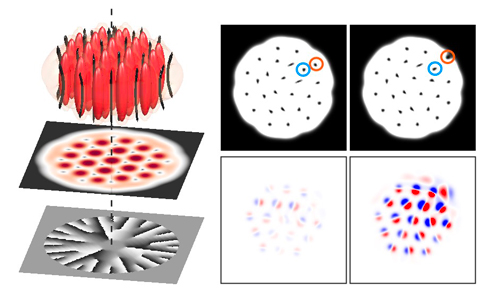
Neutron stars are tipically observed as pulsars, highly magnetized and rapidly rotating compact objects. Since their discovery in 1967, pulsars have fascinated and puzzled scientists: their periodic flash of light was so perfect that some interpreted it as alien communication.
In reality, they emit electromagnetic radiation in a narrow angular beam due to the misalignment between the magnetization and the rotation axis.
Thus the flashes occur when the stars’ rapidly rotating magnetic field points directly at Earth (lighthouse effect).
This emission is responsible for the steady spin-down of the pulsar rotation frequency. Further observation revealed a bizarre feature: at random intervals the spinning stars speed up, a phenomenon now known as a glitch. It is widely believed these events are manifestation of the presence of a superfluid component in the stellar interior. Unlike a normal fluid, a rotating superfluid can host many tiny vortices, each one carrying a small amount of angular momentum. A glitch, then, happens when many vortices jump from the inside of the star to the solid crust, trasferring angular momentum and thus speeding it up. The missing ingredient from this picture is the means to hold back and randomly release the vortices, requiring simultaneous crystalline and superfluid phases.

Figure (2). Time evolution of the frequency of a rotating supersolid with arrows indicating glitches. In the bottom, the relative variation of the frequency highlighting the glitches.
In the last years, the new supersolid phase has been observed in ultracold atom experiments here on Earth, fulfilling the conditions of simultaneous superfluid and solid.
In the collaboration work, “Glitches in rotating supersolids”, published today on Physical Review Letters, by researchers Massimo Mannarelli (Gran Sasso National Laboratory ) and Silvia Trabucco (Gran Sasso Science Institute) with the University and the Institute for Quantum Optics and Quantum Information of Innsbruck, we have shown that glitches can occur in ultracold supersolids, serving as versatile analogs of neutron stars. This study paves the way for quantum simulation of stellar objects on Earth.
The Article "Glitches in rotating supersolids" has been published online, in the 1 December 2023 issue of Physical Review Letters (Vol. 131, No. 22):
URL: https://link.aps.org/doi/10.1103/PhysRevLett.131.223401
DOI: 10.1103/PhysRevLett.131.223401
REIS - 30.11.2023


